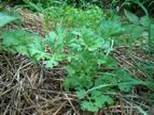Scientific Classification:
|
Other Common Names:
The other common names for the herb wormwood are Absinthe, Absinthium, Ajenjo, Common Wormwood, Green Ginger, Madderwort and Old woman Wormwood.
History



Description
Wormwood is a perennial shrub-like herb that has grayish-white colored stems wrapped with delicate and glossy hairs. They arise from a stout root stock and grow upto 1 to 4 feet in height. The leaves, which are also whitish on both sides, are about 3 inches long by 1 1/2 broad, cut into deeply and repeatedly the segments being narrow and blunt. There are two kinds of leaves-radical and stem leaves; the former being from 6 to 8 inches long, the latter from 1 to 3 inches. The stem leaves are nearly orbicular in outline and deeply incised, giving rise to that form of leaf known botanically as bi- or tri-pinnatifid.The leaf-stalks are slightly winged at the margin. The small, nearly globular flower heads are arranged in an erect, leafy panicle, the leaves on the flower-stalks being reduced to three, or even one linear segment, and the little flowers themselves being pendulous and of a greenish-yellow tint. The flowers are borne in a paniculate raceme, are tubular, hemispherical, pale-yellow or buff in color, numerous and nodding. The ripe fruits are not crowned by a tuft of hairs, or pappus, as in the majority of the Compositae family.Range
Wormwood is native to Europe; wormwood is in central Asia as well as in the eastern regions of the United States and Siberia. Currently, wormwood is commercially cultivated in all temperate regions across the world.Habitat
This therapeutic wormwood herb is generally found growing along the pavements, roadsides and waste areas. It is said to be truly indigenous near the sea.Cultivation
Wormwood likes a shady situation, and is easily propagated by division of roots in the autumn, by cuttings, or by seeds sown in the autumn soon after they are ripe. No further care is needed than to keep free from weeds. Cultivators harvest the above ground parts of the herb in late summer. Artemisia absinthium seeds will normally only germinate with light, so surface sow seeds onto a well drained seed sowing mix and lightly water in. Plant about 2 feet apart each way. Keep moist and at 17° to 20°C (about 68°F). Depending on the specific conditions, seeds will typically germinate in 14 to 30 days. It prefers soil rich in nitrogen. In the practice of companion planting, because of the secretions of its roots, it exerts an inhibiting effect on the growth of surrounding plants, thus weeds.Flowering Season
The pale yellow flowers of the wormwood are in bloom between July to October.Pests and Diseases
Artemisia is generally hardy and disease resistant, although root rot can be a problem if the soil remains too soggy. However disease and insect pests are rare when given proper cultural requirements.
Parts Used
 | The whole herb of wormwood is of both medicinal and commercial importance. |
Medicinal Applications

- A nervine tonic, particularly helpful against the falling sickness and for flatulence.
- It is a good remedy for enfeebled digestion and debility.
- Worwood functions against fungus and bacteria.
- A tincture prepared from wormwood may be helpful in healing fevers caused by intestinal parasites.
- Wormwood is a vital medication in healing jaundice as well as swelling and irritation of the gall bladder and problems in the liver. It helps in increasing hunger (appetite), augmenting digestion by enhancing the secretion of digestive enzymes.
- Wormwood can also be used to throw out worms from the body.
- Wormwood is beneficial in healing fevers and infections and it also enhances the immune system.
- The herb is also useful in getting the body rid of toxins and clearing heat and clogging in the system.
- In women it helps in inciting uterine narrowing or contractions during childbirth and helps in any liquid retention during the time of period.
- Wormwood is beneficial in releasing gas as well as easing bloating conditions.
- Wormwood steeped in vinegar and water has long been popular among the laity as a local application for injuries.
Commercial Applications

- Wormwood is generally used in the manufacture of vermouth or white wine, and also grown as a decorative plant.
- It helps in keeping pets from botheration of all kinds of pests, insects, and fleas.
- Wormwood is also an excellent insecticide and help in repelling insects.
- It is an ingredient in the liquor absinthe, and also used for flavouring in some other spirits and wines, including bitters, vermouth and pelinkovac.
Cultural Importance
According to the Ancients, Wormwood counteracted the effects of poisoning by hemlock, toadstools and the biting of the sea dragon. The plant was of some importance among the Mexicans, who celebrated their great festival of the Goddess of Salt by a ceremonial dance of women, who wore on their heads garlands of Wormwood.Folklore and Myths
This is a famous herb because it is used in the manufacture of a distilled beverage called Absinthe, which has a reputation for inducing visions. According to the Ancients, Wormwood counteracted the effects of poisoning by hemlock, toadstools and the biting of the sea dragon. The genus is named Artemisia from Artemis, the Greek name for Diana. In an early translation of the Herbarium of Apuleius we find: 'Of these worts that we name Artemisia, it is said that Diana did find them and delivered their powers and leechdom to Chiron the Centaur, who first from these Worts set forth a leechdom, and he named these worts from the name of Diana, Artemis, that is Artemisias.Wormwood is used for Psychic and Spiritual Work. Wormwood carried at the waist is said to be Protective. Hung in a muslin bag on a car's rear view mirror, it is believed by many people to Prevent Accidents. It is commonly burned on charcoal to Call up Helpful Spirits, and may be mixed with Mugwort for this purpose.


